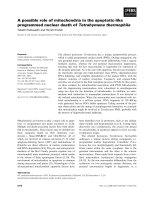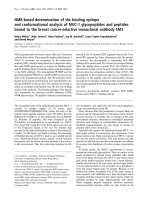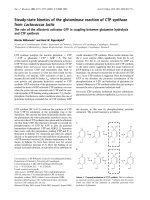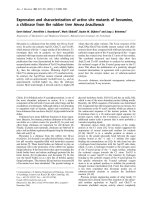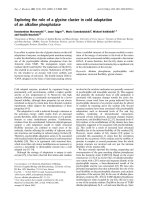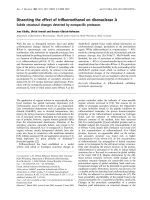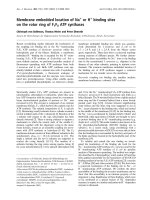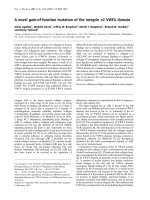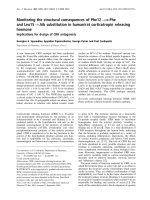Báo cáo y học: "Extending the role of lactate measurement into the prehospital environment" ppt
Bạn đang xem bản rút gọn của tài liệu. Xem và tải ngay bản đầy đủ của tài liệu tại đây (35.76 KB, 2 trang )
Available online />Page 1 of 2
(page number not for citation purposes)
Abstract
Early identification of haemodynamic shock is widely acknow-
ledged as a vital step towards improving survival. A report in the
previous issue of Critical Care describes the relationship between
lactate concentrations in blood samples analysed in the prehospital
environment and subsequent hospital mortality. These preliminary
data indicate a promising avenue of research into the treatment of
haemodynamic shock. Larger observational and interventional trials
are needed to confirm the clinical value of serum lactate
measurement in the prehospital environment.
In the previous issue of Critical Care an interesting obser-
vational study suggests a promising avenue of research that
has the potential to improve clinical outcomes [1]. The early
identification and rapid treatment of haemodynamic shock is
widely acknowledged as a vital step towards improving
survival [2]. In prehospital care, this process is particularly
challenging. Limitations of time, equipment, available skill set
and environment render the objective diagnosis of haemo-
dynamic shock difficult.
The utility of serum lactate as a tool to identify the most
seriously ill patients and to monitor their response to treat-
ment has long been recognised [3-5]. This latest investigation
describes the prognostic value of peripheral venous or
capillary blood lactate concentration, measured in 124
patients before hospital arrival by paramedic ambulance staff
using hand-held battery-powered technology [1]. The findings
confirm the expected relationship between the prehospital
serum lactate concentration and subsequent hospital
mortality. Similar findings in a much smaller investigation have
been published previously [6]. These data should encourage
further research into the prehospital use of serum lactate to
facilitate prompt identification and treatment of
haemodynamic shock and/or to indicate those patients who
might benefit from advanced activation of medical staff in the
destination hospital. Some important issues do, however,
remain unresolved.
The authors suggest that a single value of serum lactate
measured in the prehospital environment predicts hospital
mortality in this population. This suggestion may, however, be
a subtle overinterpretation of the findings. Whilst lactate
levels are clearly much greater in those patients who die, this
variable does not appear to have been included in the
multivariate analysis. It is the change in serum lactate,
between the first measurement in the community and the
second on hospital arrival, that is independently associated
with death. The importance of this distinction would depend
upon how these findings are applied in clinical practice. If
lactate measurement is incorporated into routine prehospital
care, it would probably be as part of a specific treatment
algorithm. Indeed, biomarkers can only be used to improve
clinical outcome when used as a trigger for a specific
intervention, or less commonly when used as a therapeutic
target. Accurate data on threshold values are essential if
lactate measurement is to be used in this way. In this study,
receiver operator characteristic curve analysis suggests a
lactate concentration of 3.5 mmol/l as the optimal cutoff value
for mortality prediction. If lactate is not an independent
predictor of outcome, however, then the utility of this
threshold value may be limited. As the authors themselves
suggest, larger trials are required to validate these findings.
The sample population is also too small and too hetero-
geneous to support specific conclusions regarding threshold
values for specific subgroups of patients (for example, septic
shock patients).
For similar reasons, the accuracy of lactate measurement in
peripheral venous or capillary blood samples must be
carefully considered. This is a simple and attractive approach
that allows the measurement of serum lactate in the great
majority of patients attended in the prehospital environment.
The relationship between the lactate concentration in such
samples and those drawn from an arterial or central venous
catheter, however, has not been established. Anecdotal
Commentary
Extending the role of lactate measurement into the prehospital
environment
Rupert M Pearse
Intensive Care Unit, Royal London Hospital, Barts and The London School of Medicine and Dentistry, Queen Mary’s University of London,
London E1 1BB, UK
Corresponding author: Rupert Pearse,
Published: 10 February 2009 Critical Care 2009, 13:115 (doi:10.1186/cc7687)
This article is online at />© 2009 BioMed Central Ltd
See related research by Jansen et al., />Critical Care Vol 13 No 1 Pearse
Page 2 of 2
(page number not for citation purposes)
experience suggests that lactate concentrations are often
greater in peripheral blood samples but not by a constant or
predictable margin. Any difference is likely to be of greater
importance in more severely shocked patients.
The authors are to be congratulated for completing this first
phase of a promising line of investigation. Future research
should further clarify the clinical significance of lactate
concentrations in patients with haemodynamic shock.
Interventional trials may then confirm the efficacy of serum
lactate measurements to aid the identification of these
patients and to guide their subsequent treatment.
Competing interests
The author declares that they have no competing interests.
References
1. Jansen TC, van Bommel J, Mulder PG, Rommes JH, Schieveld
SJM, Bakker J: The prognostic value of blood lactate levels rel-
ative to that of vital signs in the pre-hospital setting: a pilot
study. Crit Care 2009, 12:R160.
2. Rivers E, Nguyen B, Havstad S, Ressler J, Muzzin A, Knoblich B,
Peterson E, Tomlanovich M: Early goal-directed therapy in the
treatment of severe sepsis and septic shock. N Engl J Med
2001, 345:1368-1377.
3. Rady MY, Rivers EP, Nowak RM: Resuscitation of the critically
ill in the ED: responses of blood pressure, heart rate, shock
index, central venous oxygen saturation, and lactate. Am J
Emerg Med 1996, 14:218-225.
4. Bakker J, Gris P, Coffernils M, Kahn RJ, Vincent JL: Serial blood
lactate levels can predict the development of multiple organ
failure following septic shock. Am J Surg 1996, 171:221-226.
5. Cooper DJ: Lactic acidosis. In Oh’s Intensive Care Manual.
Edited by Bersten A, Soni N, Oh T. 5th edition. London: Butter-
worth Heinemann; 2003:107-111.
6. Coats TJ, Smith JE, Lockey D, Russell M: Early increases in
blood lactate following injury. J R Army Med Corps 2002, 148:
140-143.
